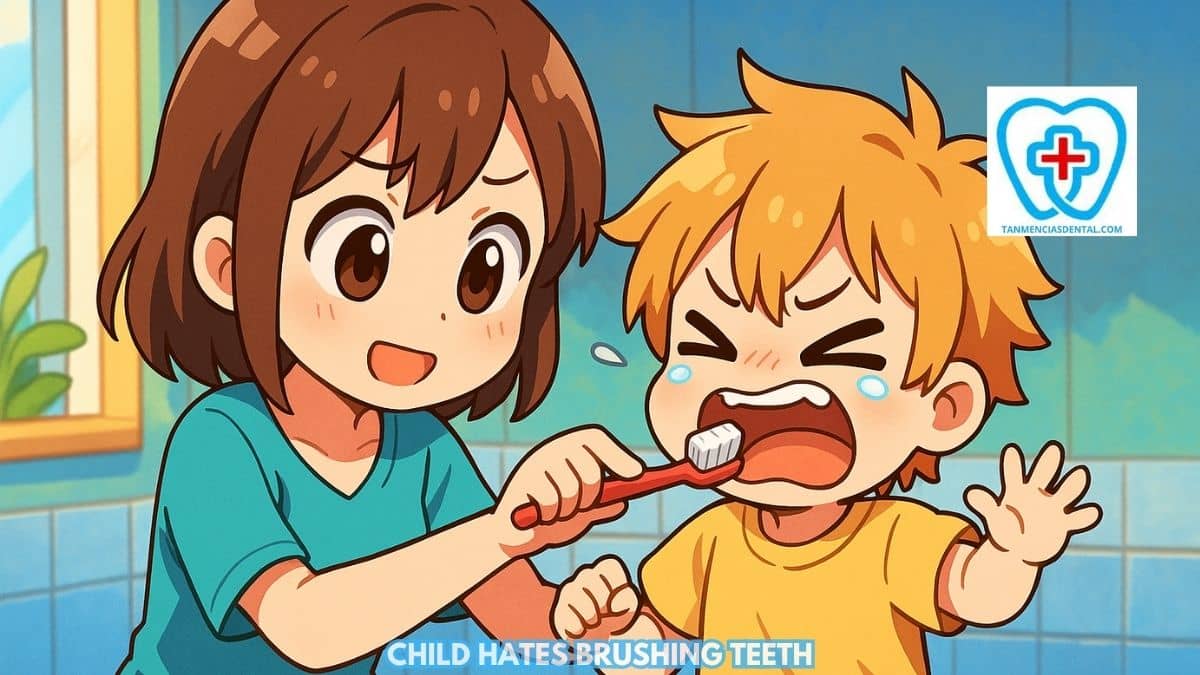Many parents struggle when their child hates brushing teeth, turning a simple task into a daily challenge.
This dislike often comes from how the toothbrush feels, the taste of the toothpaste, or the interruption to playtime.
Understanding what causes this resistance helps parents respond with patience instead of frustration.
With the right approach, brushing can shift from a battle to a positive, shared routine.
We’ll explore simple and effective ways to help children build healthy dental habits that last a lifetime.
1. Building a Strong Foundation: Early Oral Care
Establishing a strong foundation for oral care begins with introducing good habits early in your child’s life.
Before your toddler’s first tooth appears, gently clean their gums with a soft, damp cloth to remove bacteria and keep their mouth healthy.
This simple step helps your child become comfortable with oral care and prepares them for future brushing.
Once teeth begin to show, use a small, soft-bristled toothbrush and a rice-sized amount of fluoride toothpaste to clean them twice a day.
Encourage your toddler to hold the brush with you so they learn how brushing feels and why it matters.
Teaching good oral hygiene at this stage prevents cavities and supports the healthy growth of teeth and gums.
Starting early helps your child develop a positive attitude toward caring for their mouth and builds habits that can last a lifetime.
🦷 Are Electric Toothbrushes Sustainable? Worth the Hype for the Environment?
2. Baby Steps to Bright Smiles: Starting Early
Begin brushing your child’s teeth as soon as their first tooth comes in, usually around six months of age.
Use a small, soft toothbrush and a smear of fluoride toothpaste to gently clean their teeth twice daily.
Early brushing helps children become familiar with the routine and promotes healthy habits.
It also protects their developing teeth from cavities and decay, which can occur even in young children.
Consistency and patience during this stage help children adapt to the habit of brushing.
🦷 Discover the Benefits of Using an Electric Toothbrush: Worth the Switch?
3. Brush Time Fun Time: Turning Teeth Cleaning into a Game
Transforming brushing into a fun activity can encourage children to participate willingly.
Consider using toothbrushes with their favorite characters or colors to make the experience more engaging.
You can play a favorite song or use a timer to ensure they brush for the recommended two minutes, turning the activity into a mini dance party.
Offering rewards or praise for successful brushing can also motivate children.
Making brushing a positive and interactive experience helps reduce resistance and fosters a love for oral care.
🦷 Integrating Regular Dental Checkups into Your Wellness Routine
4. Let’s Brush Together: Empowering Your Child
Involving your child in the brushing process empowers them and fosters a sense of ownership.
Let them choose their own toothbrush and toothpaste, which can make the experience more personalized and exciting.
Encourage them to brush their teeth first before you help them with the harder-to-reach areas.
This approach gives them a sense of control and makes them more willing to participate.
By making brushing a shared activity, you can provide guidance while also making it a bonding experience.
🦷 How to Eat After Brushing Teeth: Tooth-Friendly Eating

5. Monkey See, Monkey Do: Setting a Good Dental Example
Children often mimic the behaviors of their parents, so setting a good example is crucial.
Brush your teeth alongside your child to show them that it’s a regular and important part of your routine too.
Use this time to demonstrate proper brushing techniques and emphasize the importance of oral hygiene.
Seeing you prioritize dental care reinforces its significance and encourages them to follow suit.
Your actions can inspire your child to adopt similar habits, making brushing a normal part of their day.
🦷 How to Get Plaque Off Your Teeth With Braces
6. How to Brush Those Pearly Whites: A Step-by-Step Guide
Teaching your child the correct way to brush is essential for keeping their teeth clean and healthy.
Begin by showing them how to hold the toothbrush at a 45-degree angle to the gums so that the bristles reach where the teeth and gums meet.
Use gentle circular motions and make sure they clean the outer, inner, and chewing surfaces of every tooth.
Remind your child to brush their tongue lightly to remove bacteria and keep their breath fresh.
Once brushing becomes part of their routine, introduce how to floss so they can clean between teeth where a brush cannot reach.
Demonstrate how to use floss gently between each tooth and explain that it helps prevent cavities and gum problems.
By guiding them through each step, you help your child build the confidence and skills needed for lifelong oral health.
🦷 Exploring the Benefits of Angled Toothbrushes
7. Overcoming Obstacles: Dealing with Brush Time Battles
Dealing with resistance to brushing requires patience and understanding.
Some children may have hypersensitivity to texture, taste, or sound, which can make brushing uncomfortable or even upsetting.
If this happens, try softer toothbrushes, flavor-free toothpaste, or a quieter setting to help your child relax.
Encourage them to touch the brush, smell the toothpaste, and practice gentle motions so they start to feel more comfortable.
Celebrate small progress, such as when they say they want to brush or hold the toothbrush on their own.
Keep your tone calm and supportive to avoid turning brushing into a stressful experience.
With time, these small adjustments can help your child overcome discomfort and feel confident about keeping their teeth clean.
🦷 What Makes the Best Teeth Whitening Courses Stand Out from Others?
8. When Brushing Just Won’t Happen: Simple Ways to Stay on Track
Some days, children refuse to brush no matter what parents try, but there are still small ways to protect their teeth.
Wiping their teeth with xylitol wipes or a clean, damp gauze can remove some plaque and keep their mouth fresh.
Older kids can use xylitol chewable tablets to help reduce bacteria when brushing is skipped.
If the child resists completely, start with brushing just one tooth to keep the habit alive and try again later when they are calmer.
The goal is to keep brushing part of the routine without turning it into a fight, so the child continues to see it as a normal daily activity.
🦷 How to Reduce the Swelling After Wisdom Teeth Removal
9. Turning Challenges into Opportunities: Encouraging Consistency
Creating a consistent brushing schedule helps reinforce the habit and make it part of your child’s daily routine.
Link brushing times to regular activities, such as after meals or before bedtime, to establish a predictable pattern.
Encourage your child by celebrating small successes, such as remembering to brush on their own or brushing for the full two minutes.
Use visual aids like charts or stickers to track their progress and keep them motivated.
Consistency and positive reinforcement help turn challenges into opportunities for developing lifelong habits.
🦷 What Is the Best Way to Brush Your Teeth with Braces?
10. Fueling Healthy Smiles: The Link Between Diet and Dental Health
A balanced diet plays a major role in keeping your child’s teeth and gums healthy.
Limiting sugary snacks and drinks helps prevent cavities and tooth decay that can weaken the enamel.
Encourage your child to eat a variety of fruits and vegetables since they provide important vitamins and minerals for strong teeth and gums.
Calcium-rich foods like milk, cheese, and yogurt help strengthen the jaw and support proper tooth development.
Foods high in protein, such as eggs and lean meats, also contribute to building healthy bone and jaw structure.
Teaching your child how the foods they eat affect their teeth helps them make smarter food choices every day.
A nutrient-rich diet supports lasting oral health and keeps their smile strong and bright.
🦷 Basic Dental Needs in Marikina
11. Keep Those Smiles Shining: The Importance of Dental Checkups
Regular dental checkups are essential for protecting your child’s oral health and preventing problems before they start.
During these visits, the dentist can look for early signs of cavities, gum issues, or tooth alignment problems that may need attention.
Pediatric dentistry focuses on caring for children’s unique dental needs and making visits comfortable and educational.
Many pediatric dental offices use child-friendly spaces and simple language to help reduce anxiety.
These visits also give parents a chance to learn about brushing techniques, fluoride use, and healthy eating habits for strong teeth.
Consistent care through pediatric dentistry ensures that your child’s smile stays healthy and confident as they grow.
🦷 Tan-Mencias Family Oral Health Clinic
👨⚕️ Conclusion
Cultivating positive dental habits in your child requires time, patience, and creativity, but the rewards are well worth the effort.
By making brushing a fun and engaging activity, you help your child develop a positive attitude towards oral care.
Encouraging consistency, setting a good example, and prioritizing a healthy diet all contribute to strong dental habits.
With your guidance and support, your child can enjoy a lifetime of healthy teeth and gums.
These habits will benefit them throughout their lives, ensuring a confident and bright smile.
😊 Self-Promotion
Visit Tan-Mencias Dental Clinic in Parang, Marikina City, for a welcoming and professional dental care experience.
Our skilled team is dedicated to providing personalized care to ensure your smile is healthy and bright.
Whether you need a routine checkup, dental cleaning, or specialized treatment, we are here to meet your needs with a friendly approach.
Please use the contact form on our website, call us at 0917-145-1074, or send us a message on our Facebook page if you have any questions or would like to arrange an appointment.
We look forward to helping you achieve the smile you deserve!
❔ FAQs
1. What should I do if my child refuses to brush their teeth every night?
Stay calm and avoid turning brushing into an argument.
Offer choices, like which toothbrush to use or whether to brush before or after storytime.
If they still refuse, use xylitol wipes or encourage rinsing with water to remove some plaque.
Try again later when your child is calmer.
The goal is to keep brushing as part of the daily routine, even if only partly done at first.
2. How can I make brushing more fun for my child?
Use songs, stories, or short videos to make brushing entertaining.
Let your child choose a colorful toothbrush or toothpaste with a flavor they like.
Turn brushing into a two-minute game or a race against a timer.
Giving praise or small rewards can help motivate them.
Making it playful helps your child see brushing as something positive instead of a chore.
3. What kind of toothpaste is best if my child hates the taste?
Choose a mild or fruit-flavored toothpaste made for children.
Some brands offer unflavored or low-foam options that feel less harsh.
Check that the toothpaste has fluoride for cavity protection.
Avoid strong mint or spicy flavors that young children often dislike.
If one brand fails, try another until you find one your child accepts.
4. When should I start brushing my child’s teeth?
Begin cleaning your baby’s gums with a soft, damp cloth before teeth appear.
Once the first tooth comes in, use a baby toothbrush with a smear of fluoride toothpaste.
Brush twice a day, morning and night.
Early brushing helps your child get used to the routine.
It also prevents cavities from forming in new teeth.
5. How can I help my child feel comfortable at the dentist?
Choose a pediatric dentist who works well with children and explains things in simple language.
Talk about dental visits as a normal, helpful part of keeping teeth strong.
Read books or watch short videos about dentist visits beforehand.
Stay positive and calm during appointments to show there’s nothing to fear.
Over time, your child will see dental visits as friendly and routine.

